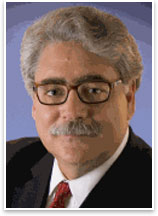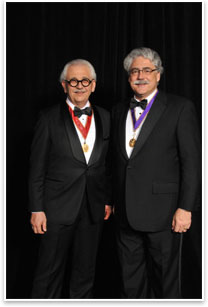George H. Miller, FAIA, Sworn in as 86th AIA President
Inaugural address underscores the theme “Design Matters” and
core values of beauty, sustainability, health, safety, and productivity
Summary: George H. Miller, FAIA, partner at Pei Cobb Freed & Partners LLP, was inaugurated as the AIA’s 2010 President during ceremonies held on December 4 in Washington, DC.
In turning the reins over to Miller, outgoing AIA President Marvin J. Malecha, FAIA, proclaimed: “I am honored with the responsibility to vest the trust of our Institute to the leadership of George Miller. I do this with great confidence and optimism. This is a man of a larger-than-life appreciation for our profession. He is a human spirit that energizes every room he comes into. He knows in his heart and in his soul that it is the passion for design that underpins and fuels every act and aspiration of our members.”
Watch a
video of Miller’s inaugural address. Highlights of
his speech follow.

Miller inaugural address highlights
“Several years ago, when I began to think about service to this organization, some were skeptical. Why, they asked, are you interested in the AIA? Why devote all that time and energy? What
can they do for you?”
For me, the answer wasn’t difficult. Let me explain why.
My life has been enriched by architecture—by its beauty and the spaces that architects create. But even more than beauty, I’m inspired by the value architects bring to their communities. We should celebrate this, and celebrate the joy that comes when architects make a positive difference in people’s lives.

2009 AIA President Marvin
J. Malecha, FAIA, (l) and Miller.
Celebrations and joy feel better when shared. Our clients and the
public must be part of this celebration. To bring them on board,
we must commit ourselves to elevate everyone’s understanding of the importance and power of design. Design is a tool, a resource, a power for the creation of beautiful, more sustainable, safe, healthy, and livable communities. Not for a privileged few, but for everyone.
The AIA is the place for our profession to dialogue with the public
. . . the place to celebrate the outstanding legacy and wonderful
possibilities of design.
The AIA connects people—clients, public officials, community leaders,
students, intern architects, academics, researchers, engineers, builders,
specialists, and many others. It’s where we give a voice to
all those who are passionate about the built environment and the beauty of
architecture.
We must build on the achievement of past leaders and work with you, today’s leaders, to make that voice strong for collaboration
- in the studio, at the construction site, and in the halls of Congress.
- In the classroom where our children learn and in the hospitals where the sick are healed.
- In the homes of the elderly who want to age in place and for the handicapped child seeking freedom by design.
Learning from the past
“As chair of the committee
planning the events around the 150th anniversary of the AIA’s
founding, I learned much about how the profession has evolved from
the days when a dozen architects met in the Manhattan office of Richard
Upjohn, the architect of New York’s Trinity Church.
In 1857 architects faced a depressed economy. Credit had frozen in the face of a financial panic. Projects ground to a halt, the construction industry cratered, and firms were cutting their staff. Even Upjohn, one of the nation’s most prominent architects, had trouble finding clients.
Sound familiar? In some important ways, the times were worse.
When the AIA was founded, schools of architecture did not exist. There were no building codes. The health safety and welfare of the public was not assured. Architecture practice was being challenged by the radical technological changes of the Industrial Revolution.
Here’s where we come to the brilliance of Upjohn’s insight: Contrary to what a more timid mind would have concluded in the face of unprecedented challenges, Upjohn didn’t flinch. He realized this was precisely the right time to be bold.
If there were a chance that architects were to survive the economic and technological challenges of 1857, they had to pull together. That insight triggered everything we’ve come to take for granted—schools of architecture, architecture libraries open to the public, and standard contract documents. In fact, the very idea of a profession itself.
A pivotal time, again
“One hundred
and fifty-two years later, we are again at a pivotal time, a time
that calls for faith in the future and boldness, not unlike that
shown by Richard Upjohn. A time that calls on all of us to pull together.
Whether we practice in a small community in Pennsylvania, designing kitchens or a small addition; or in a regional practice in St. Louis designing the schools of tomorrow; or if we are working in a large international office based in San Francisco working on mega-scaled projects on the Pacific Rim, design is the common thread that ties us together. Design matters.
This is our time
“Never before in history
have the talents, skills, the broad vision, and ideals of our profession
been more urgently needed. We have the skills to be the defenders
of the environment, while caring for and addressing some of humanity’s
most basic needs.
Thomas Edison, a man who knew something about the power of design, once said: ‘If we did all the things we’re capable of, we would astound ourselves.’
Imagine turning loose all the talent of AIA members and focusing it on better schools, affordable housing, mass transportation, sustainable communities, public health, indeed the very health of the profession itself. What might we accomplish? We would astound ourselves.
With your help, that will be our agenda for the year to come—to celebrate architecture and to work with AIA members everywhere to astound ourselves and those we serve.
The template for collaborative action was set over 150 years ago. It has served us well and will be the road to a better future.
That better future will surely come. It will come because there’s so much that’s eager to be born for the good of our planet. The question is not a matter of ability. We have the tool—design.
The question for us here tonight is this: What can we do together to enable America’s architects to extend to everyone the healing power of design?
I believe in our profession, I believe in the strength of our organization, and I believe that even in these difficult times architects will lead the way to a better future. We will emerge stronger in response to our current challenges. Together we will envision and build for the new decade that beckons and beyond.
Imagine the possibilities: Architects driving positive change through the power of design!
This is our time! What are we waiting for?”
|



